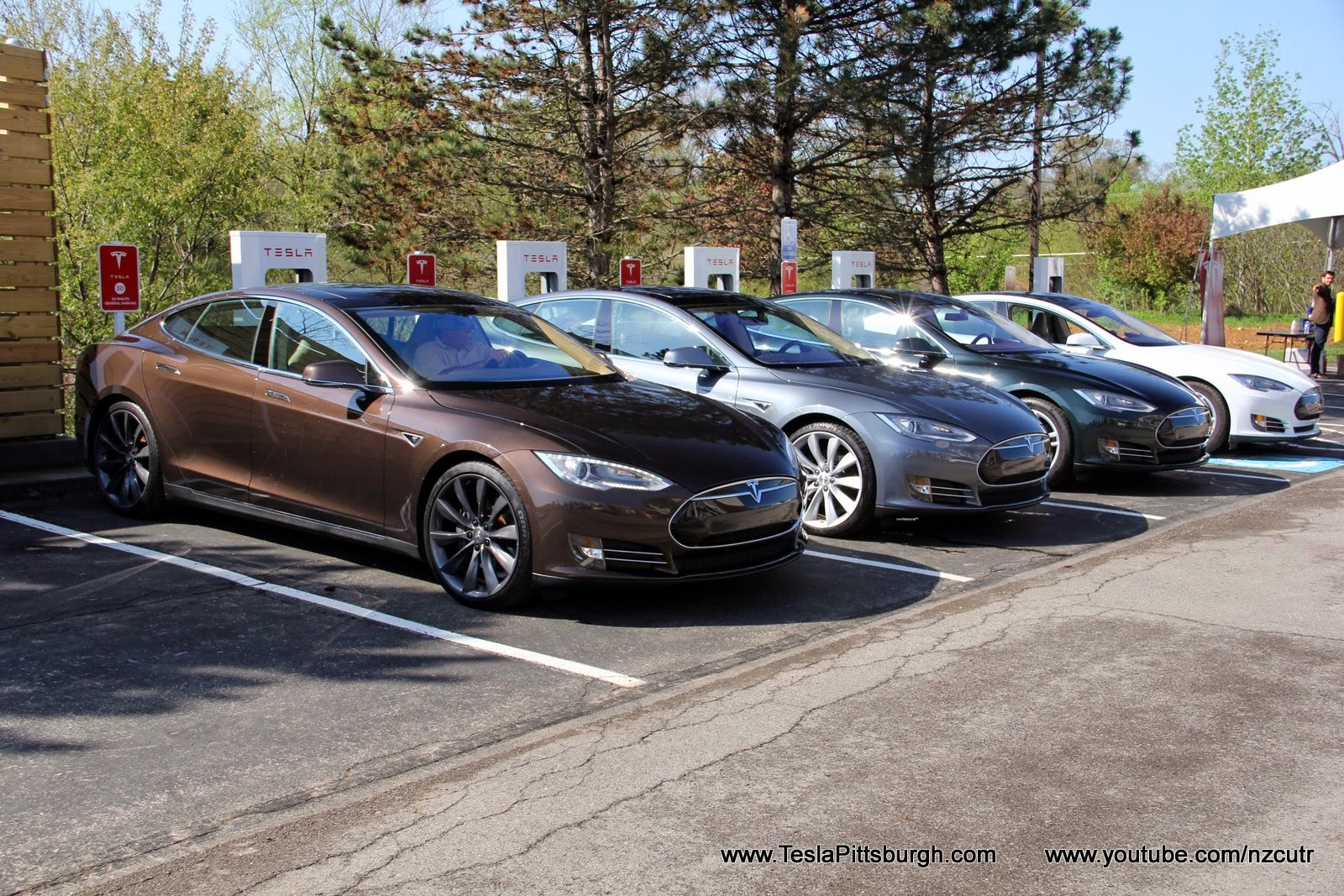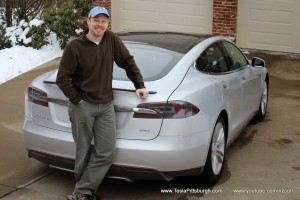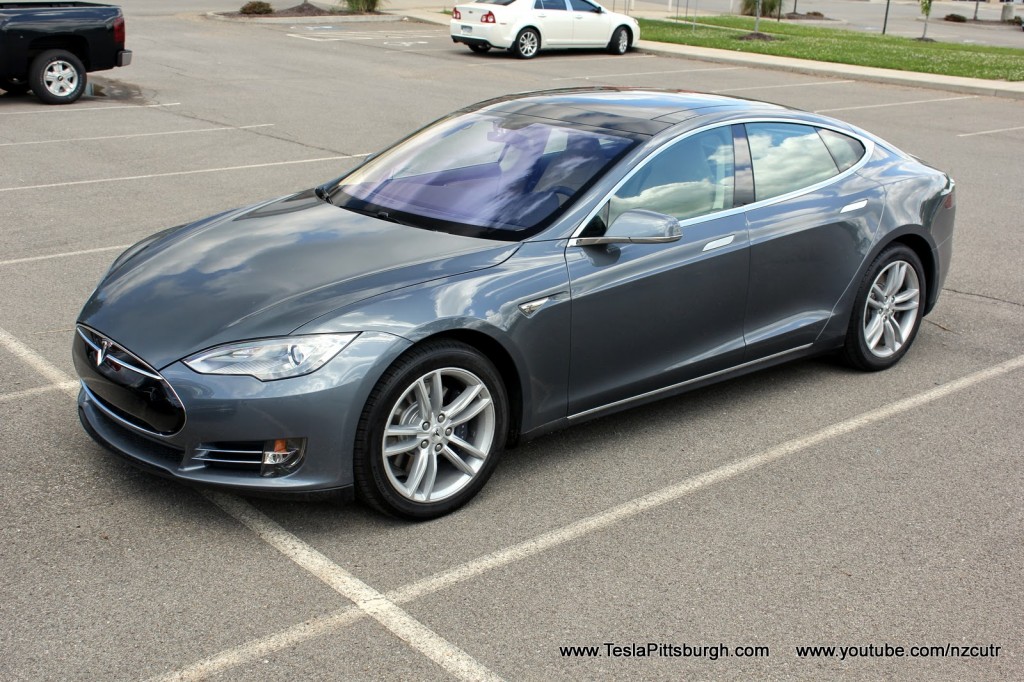News
Should I Buy the Tesla Model S P85 or Standard 85kWh?


It is, perhaps, the biggest question many prospective hand-wringing owners of the Model S wrestle with – should I get the Tesla Model S P85 or stick to the Standard version?
After all, once you’ve talked yourself up the first $10k from a 60kwh to an 85kwh battery, what’s another $12K or so for the Performance version?
And if you don’t pay for the upgrade to the more powerful drivetrain, WILL YOU REGRET IT LATER?! Want to know the bottom line? My journey to owning the Model S led me to ask the following questions: Will you regularly drive over 180 miles/day? Will you use the Tesla for a road trip car? If the answer to both those questions is “No”, get the 60 kWh. Period. Done.
 The 60 has comparable real world performance to the 85 and reportedly feels even more spirited because of less battery weight (though ballasted to match an 85, the ballast is apparently located differently somehow, according to reports from people who have driven both). The 60 is a superb in-town commuter car or medium distance tourer (with destination charging). If either those questions are answered with a “Yes”, get the 85kWh. By the time you pay the extra $2k to enable the Supercharging option on a 60 you’ve already started toward an 85 anyway. Like the evil dojo master in Karate Kid said, “Finish him!” Get an 85. Now don’t go crazy right to the P85+, let’s look at the upper extreme first.
The 60 has comparable real world performance to the 85 and reportedly feels even more spirited because of less battery weight (though ballasted to match an 85, the ballast is apparently located differently somehow, according to reports from people who have driven both). The 60 is a superb in-town commuter car or medium distance tourer (with destination charging). If either those questions are answered with a “Yes”, get the 85kWh. By the time you pay the extra $2k to enable the Supercharging option on a 60 you’ve already started toward an 85 anyway. Like the evil dojo master in Karate Kid said, “Finish him!” Get an 85. Now don’t go crazy right to the P85+, let’s look at the upper extreme first.
The P85+ is apparently designed solely for the purpose of destroying tires – rear tires – every 5,000 miles or less. Unless you’re coming from a high performance car or plan to enjoy track days, fuggeddaboutit. It’s basically an even more expensive version of the P85 with staggered tires and other suspension tricks. Real world, this is overkill and more about badge ego than useful value (for the vast majority of non-professional racing drivers).
 Speaking of real world, the performance difference for the P85 and the S85 exists primarily in one place: 0-30mph. That’s it. From 30mph and up they are virtually identical and both will silently roar around slower traffic with equal capability. Originally the Tesla Model S P85 upgrade only came with some other standard features that are a mixed bag (to me). Thankfully Tesla has decided to allow buyers the option of upgrading only the drivetrain. Still, that presents some problems. A P85 with the 19″ wheels just overwhelms them. Remember the only performance advantage it has is 0-30mph and that requires grip to actually enjoy it. For a variety of reasons (but chief among them rolling resistance and wind resistance) Tesla’s tires are taller rather than wider to increase their contact patch. A traditional sports sedan would get wider tires to increase grip but the Model S gets taller tires… ergo, a P85 on 19s just bounces off the traction control constantly. In a sunny climate that might not happen as often but here in pothole country you’ll get clunks and shudders from way back there at the wheels all the time as the traction control tries to reign in your lunacy. My friend Jake and I had several days with a silver loaner (read more about it here) and it was fun but also frustrating.
Speaking of real world, the performance difference for the P85 and the S85 exists primarily in one place: 0-30mph. That’s it. From 30mph and up they are virtually identical and both will silently roar around slower traffic with equal capability. Originally the Tesla Model S P85 upgrade only came with some other standard features that are a mixed bag (to me). Thankfully Tesla has decided to allow buyers the option of upgrading only the drivetrain. Still, that presents some problems. A P85 with the 19″ wheels just overwhelms them. Remember the only performance advantage it has is 0-30mph and that requires grip to actually enjoy it. For a variety of reasons (but chief among them rolling resistance and wind resistance) Tesla’s tires are taller rather than wider to increase their contact patch. A traditional sports sedan would get wider tires to increase grip but the Model S gets taller tires… ergo, a P85 on 19s just bounces off the traction control constantly. In a sunny climate that might not happen as often but here in pothole country you’ll get clunks and shudders from way back there at the wheels all the time as the traction control tries to reign in your lunacy. My friend Jake and I had several days with a silver loaner (read more about it here) and it was fun but also frustrating.
Unfortunately, if you’re living anywhere with four seasons you are NOT going to want to alleviate the traction problem by getting 21″ wheels. We have potholes. LOTS of them. BIG ones. And bridges with expansion joints that will turn those wheels into ovals. You know how when you go to the grocery store you always get a cart with that annoying wobbly wheel? Would you like to buy one for $90-100K? I didn’t think so. Speaking of expenses, many P85 owners report higher than average tire wear (regardless of wheel size).
I don’t know of a true head-to-head drag race video of all THREE versions of the Model S (60/85/P85)– amazed no one has done it yet– but the video above is very recent and posts a time faster than the Tesla website does. You can read more opinions on that video HERE.
Another recent video does offer a head-to-head of a standard Tesla Model S P85 vs S85 and you can see that after the first 30 feet or so, the S85 and the P85 match stride-for-stride. In fact, at the end of the 1/4 the trap speed on the standard 85 is actually higher. Skip ahead 26 seconds to catch the Tesla family feud.
One long-time P85 owner asserts the difference in launch speed really only exists at higher states of charge. As a result, maintaining that performance edge over the S85 requires more frequent and fuller charges of the main pack, potentially increasing long-term degradation. Ironically, the only times you really should charge the pack up to higher levels (for distance), you wouldn’t want to enjoy the harder launches because it would adversely affect your range.
So the S85 is a tad slower off the line. No one but a P85 owner is ever going to know that. And, frankly, the power delivery at launch is a lot smoother. The P85 is pretty brutal. Oh, it’s damn impressive– but it’s also jarring. I like the slightly tapered building on of WHOOSH that I get from the S85. I think it keeps my wife from realizing how often I’m toying with the other cars around us. James Bond, after all, wears a suit… not a karategi. <— brought that back to Karate Kid nicely, didn’t I? I have no idea why either.

Clearly I could go on and on about my configuration thought processes– and how they’ve evolved since taking delivery– but that’s a topic for another time. If you haven’t already read about my “Journey to Tesla” then check it out for some insights into how I got this car in my driveway and how you can too. It starts by clicking RIGHT HERE.
Read more at www.TeslaPittsburgh.com and check out the videos on our YouTube channel at www.YouTube.com/NZCUTR.

News
Tesla Diner becomes latest target of gloom and doom narrative

The Tesla Diner has been subject to many points of criticism since its launch in mid-2025, and skeptics and disbelievers claim the company’s latest novel concept is on its way down, but there’s a lot of evidence to state that is not the case.
The piece cites anecdotal evidence like empty parking lots, more staff than customers during a December visit, removed novelty items, like Optimus robot popcorn service and certain menu items, the departure of celebrity chef Eric Greenspan in November 2025, slow service, high prices, and a shift in recent Google/Yelp reviews toward disappointment.
The piece frames this as part of broader Tesla struggles, including sales figures and Elon Musk’s polarizing image, calling it a failed branding exercise rather than a sustainable restaurant.
This narrative is overstated and sensationalized, and is a good representation of coverage on Tesla by today’s media.
Novelty Fade is Normal, Not Failure
Any hyped launch, especially a unique Tesla-branded destination blending dining, Supercharging, and a drive-in theater, naturally sees initial crowds taper off after the “Instagram effect” wears down.
Tesla makes major change at Supercharger Diner amid epic demand
This is common for experiential spots in Los Angeles, especially pop-up attractions or celebrity-backed venues. The article admits early success with massive lines and social media buzz, but treats the return to normal operations as “dying down.”
In reality, this stabilization is a healthy sign of transitioning from hype-driven traffic to steady patronage.
Actual Performance Metrics Contradict “Ghost Town” Claims
- In Q4 2025, the Diner generated over $1 million in revenue, exceeding the average McDonald’s location
- It sold over 30,000 burgers and 83,000 fries in that quarter alone. These figures indicate a strong ongoing business, especially for a single-location prototype focused on enhancing Supercharger experiences rather than competing as a mass-market chain
It’s not a ghost town lol. The @Tesla Diner still had over 30,000 burger orders and 83,000 fries orders in Q4. The diner generated over $1M in revenue in Q4, a $4M annual run rate, which is more than the average McDonald’s…. pic.twitter.com/XvAGLUqxej
— Sawyer Merritt (@SawyerMerritt) January 4, 2026
Conflicting On-the-Ground Reports
While the article, and other similar pieces, describe a half-full parking lot and sparse customers during specific off-peak visits, other recent accounts push back:
- A January 2026 X post noted 50 of 80 Supercharger stalls were busy at 11 a.m., calling it “the busiest diner in Hollywood by close to an order of magnitude
TESLA DINER 🍔
Frantic!!!
Crazy busy. pic.twitter.com/wMbmr8SFFn
— Rich & Sharon (@HullTeslaModel3) January 4, 2026
- Reddit discussions around the same time describe it as not empty when locals drive by regularly, with some calling the empty narrative “disingenuous anti-Tesla slop.”
When we visited it last week it was packed. We had to wait to enter, get a table and go to the restroom. We were lucky to find a spot to charge.
— Rani G (@ranig) January 4, 2026
Bottom Line
The Tesla Diner, admittedly, is not the nonstop circus it was at launch–that was never sustainable or intended. But, it’s far from “dying” or an “empty pit stop.”
It functions as a successful prototype: boosting Supercharger usage, generating solid revenue, and serving as a branded amenity in the high-traffic EV market of Los Angeles.
News
Tesla stands to win big from potential adjustment to autonomous vehicle limitations
Enabling scale, innovation, and profitability in a sector that is growing quickly would benefit Tesla significantly, especially as it has established itself as a leader.

Tesla stands to be a big winner from a potential easing of limitations on autonomous vehicle development, as the United States government could back off from the restrictions placed on companies developing self-driving car programs.
The U.S. House Energy and Commerce subcommittee will hold a hearing later this month that will aim to accelerate the deployment of autonomous vehicles. There are several key proposals that could impact the development of self-driving cars and potentially accelerate the deployment of this technology across the country.
These key proposals include raising the NHTSA’s exemption cap from 2,500 to 90,000 vehicles per year per automaker, preempting state-level regulations on autonomous vehicle systems, and mandating NHTSA guidelines for calibrating advanced driver assistance systems (ADAS).
Congress, to this point, has been divided on AV rules, with past bills like the 2017 House-passed measure stalling in the Senate. Recent pushes come from automakers urging the Trump administration to act faster amid competition from Chinese companies.
Companies like Tesla, who launched a Robotaxi service in Austin and the Bay Area last year, and Alphabet’s Waymo are highlighted as potential beneficiaries from lighter sanctions on AV development.
The NHTSA recently pledged to adopt a quicker exemption review for autonomous vehicle companies, and supporters of self-driving tech argue this will boost U.S. innovation, while critics are concerned about safety and job risks.
How Tesla Could Benefit from the Proposed Legislation
Tesla, under CEO Elon Musk’s leadership, has positioned itself as a pioneer in autonomous driving technology with its Full Self-Driving software and ambitious Robotaxi plans, including the Cybercab, which was unveiled in late 2024.
The draft legislation under consideration by the U.S. House subcommittee could provide Tesla with significant advantages, potentially transforming its operational and financial landscape.
NHTSA Exemption Cap Increase
First, the proposed increase in the NHTSA exemption cap from 2,500 to 90,000 vehicles annually would allow Tesla to scale up development dramatically.
Currently, regulatory hurdles limit how many fully autonomous vehicles can hit the roads without exhaustive approvals. For Tesla, this means accelerating the rollout of its robotaxi fleet, which Musk envisions as a network of millions of vehicles generating recurring revenue through ride-hailing. With Tesla’s vast existing fleet of over 6 million vehicles equipped with FSD hardware, a higher cap could enable rapid conversion and deployment, turning parked cars into profit centers overnight.
Preempting State Regulations
A united Federal framework would be created if it could preempt State regulations, eliminating the patchwork of rules that currently complicate interstate operations. Tesla has faced scrutiny and restrictions in states like California, especially as it has faced harsh criticism through imposed testing limits.
A federal override of State-level rules would reduce legal battles, compliance costs, and delays, allowing Tesla to expand services nationwide more seamlessly.
This is crucial for Tesla’s growth strategy, as it operates in multiple markets and aims for a coast-to-coast Robotaxi network, competing directly with Waymo’s city-specific expansions.
Bringing Safety Standards to the Present Day
Innovation in the passenger transportation sector has continued to outpace both State and Federal-level legislation, which has caused a lag in the development of many things, most notably, self-driving technology.
Updating these outdated safety standards, especially waiving requirements for steering wheels or mirrors, directly benefits Tesla’s innovative designs. Tesla wanted to ship Cybertruck without side mirrors, but Federal regulations required the company to equip the pickup with them.
Cybercab is also planned to be released without a steering wheel or pedals, and is tailored for full autonomy, but current rules would mandate human-ready features.
Streamlined NHTSA reviews would further expedite approvals, addressing Tesla’s complaints about bureaucratic slowdowns. In a letter written in June to the Trump Administration, automakers, including Tesla, urged faster action, and this legislation could deliver it.
In Summary
This legislation represents a potential regulatory tailwind for Tesla, but it still relies on the government to put forth action to make things easier from a regulatory perspective. Enabling scale, innovation, and profitability in a sector that is growing quickly would benefit Tesla significantly, especially as it has established itself as a leader.
News
Nvidia CEO Jensen Huang explains difference between Tesla FSD and Alpamayo
“Tesla’s FSD stack is completely world-class,” the Nvidia CEO said.

NVIDIA CEO Jensen Huang has offered high praise for Tesla’s Full Self-Driving (FSD) system during a Q&A at CES 2026, calling it “world-class” and “state-of-the-art” in design, training, and performance.
More importantly, he also shared some insights about the key differences between FSD and Nvidia’s recently announced Alpamayo system.
Jensen Huang’s praise for Tesla FSD
Nvidia made headlines at CES following its announcement of Alpamayo, which uses artificial intelligence to accelerate the development of autonomous driving solutions. Due to its focus on AI, many started speculating that Alpamayo would be a direct rival to FSD. This was somewhat addressed by Elon Musk, who predicted that “they will find that it’s easy to get to 99% and then super hard to solve the long tail of the distribution.”
During his Q&A, Nvidia CEO Jensen Huang was asked about the difference between FSD and Alpamayo. His response was extensive:
“Tesla’s FSD stack is completely world-class. They’ve been working on it for quite some time. It’s world-class not only in the number of miles it’s accumulated, but in the way it’s designed, the way they do training, data collection, curation, synthetic data generation, and all of their simulation technologies.
“Of course, the latest generation is end-to-end Full Self-Driving—meaning it’s one large model trained end to end. And so… Elon’s AD system is, in every way, 100% state-of-the-art. I’m really quite impressed by the technology. I have it, and I drive it in our house, and it works incredibly well,” the Nvidia CEO said.
Nvidia’s platform approach vs Tesla’s integration
Huang also stated that Nvidia’s Alpamayo system was built around a fundamentally different philosophy from Tesla’s. Rather than developing self-driving cars itself, Nvidia supplies the full autonomous technology stack for other companies to use.
“Nvidia doesn’t build self-driving cars. We build the full stack so others can,” Huang said, explaining that Nvidia provides separate systems for training, simulation, and in-vehicle computing, all supported by shared software.
He added that customers can adopt as much or as little of the platform as they need, noting that Nvidia works across the industry, including with Tesla on training systems and companies like Waymo, XPeng, and Nuro on vehicle computing.
“So our system is really quite pervasive because we’re a technology platform provider. That’s the primary difference. There’s no question in our mind that, of the billion cars on the road today, in another 10 years’ time, hundreds of millions of them will have great autonomous capability. This is likely one of the largest, fastest-growing technology industries over the next decade.”
He also emphasized Nvidia’s open approach, saying the company open-sources its models and helps partners train their own systems. “We’re not a self-driving car company. We’re enabling the autonomous industry,” Huang said.








